Written By Bobby. On Mar 07. In Shop Systems
I thought my dust collector worked pretty well until I was emptying the lower dust bag and noticed something. It makes total sense, but I just didn’t really think about it before.
I’ve always had the ultimate dust collection system as my goal, and have several improvements on my list. Enlarging the dust ports from 4” to 6” on my jointer, making a dust extraction blade guard for my table saw, and increasing the duct drop size to my drum sander are the main ones. But now I’ve started to rethink the “back end” of the system woodworkers don’t normally worry about.
Not Just an Automatic Broom
A dust collection system isn’t just an automated way of sweeping up your workshop. I bought a dust collector originally so that I wouldn’t have to run out of the shop after cutting tons of boards and wait for the dust cloud to clear using a fan and opening the side door. I thought of a dust collector as a tremendous time-saving device, allowing me to use tools without sweeping up or worry about breathing dust.
To further save shop time, I decided on a central system that was ducted to each machine so I wouldn’t have to wheel it over and hook up a flex hose. I knew I’d tend to make cuts without it if I had to do that.
So I bought a Jet dust collector, model DC-1100A. I use two 5” diameter duct mains branching off of a 6” riser from the collector, each covering half the shop so that each main has a shorter run, reducing static pressure (resistance to airflow). I have blastgates at each machine to allow the full capacity of the dust collector to focus on the tool I’m using (one at a time).
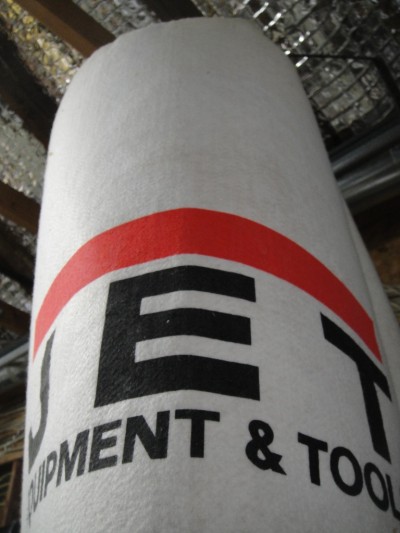
The motor and impeller work fine, but the lower bag is able to breathe but doesn’t filter fine dust. This bag was an upgrade (I think 5 microns, but unknown % efficiency), and really isn’t enough surface area. I need something that will filter down to 1 micron at 90-something percent.
What’s Wrong
My ductwork, a subject for another article, could use improvement, but works ok for now. I’m getting somewhat close to the air quantity (measured in cubic feet per minute, or CFM) that OSHA recommends for machines that are close to each 5” main, but it’s not quite there for the machines at the end of each main duct run. Increasing the dust port connection sizes, buying smooth-bore flex duct to replace some rougher duct I have, and upsizing the duct drop/ branch diameters, are all part of the solution. The other is to further reduce the system’s static pressure on the other side of the fan, the filter bags. I could also get a more powerful 220V dust collector, but that’s going to have to wait.
What I noticed while changing the dust bin is that the lower bag had a super-fine coating of dust on it, and all over the white enamel paint of the dust collector’s frame. It was very obvious this time because I was cutting Padauk which has a reddish dust. I then realized my lower bag was passing fine dust and spraying it all over my shop, where the suspended particles were part of what I was breathing.
The upper bag filter was an upgrade. It’s a thick felt bag designed (theoretically) to filter down to 5 microns. The lower bag functions as a breather bag just like the top bag, so it too should filter down to 5 microns. But it doesn’t. It’s a woven polyester, and filters down to maybe 30 microns. I keep reading articles saying 10 microns and less are more dangerous because our body has a hard time getting rid of them, and doesn’t do a good job of filtering them. So, cumulative damage occurs.
Because the lower bag functions as a filter, the air each tool is getting changes as the bag fills with chips and dust because the filter surface area gets reduced. So my already minimal CFM becomes way below the air needed to pull in the smaller particles at that point.
One more thing that’s wrong with my setup is that the overall filter surface area could be increased quite a bit with a custom bag, reducing the static pressure on that side of the fan. Having a small restrictive filter is a waste because it’s so easily fixed. Until I upgrade my motor and impeller, or buy a good cyclone, I want to maximize the air I’m pulling from my machines, particularly the ones furthest away.
So, two problems (at least):
- Too much filter static pressure thus reducing the CFM I need, and
- Small particles are getting pumped into my shop air
Designing Dust Extraction with More Than Filtration in Mind
While this article focuses on filtration, keep in mind that if chips, shavings, large dust particles, and small dust particles don’t make it to your dust collector it won’t matter how good your filters are.
So that means capturing the dust at the source (as you’ve read many times before). Blades and bits fling the particles at high speed, so you want to make sure your machines incorporate some sort of shield or hood to deflect and contain these so they can be drawn into the airstream. For my table saw, SawStop makes an overarm guard designed with dust collection in mind.
Also, make sure you’re getting the recommended air quantity (CFM) to each woodworking tool. Right now I’m doing some research (including the help of my friend at Cal-OSHA and other recognized standards) to get a better understanding of what my target CFM values should really be. Finally, your ducts (and dust ports) have to be sized to handle the recommended CFM at a low static pressure while maintaining enough velocity (air speed) to carry the chips and dust or you’ll get clogs and increase fire risk.
That means that you can’t make your ducts too small OR too big. Too small and there will be too much resistance to airflow (static pressure) and your fan will deliver a lower CFM than you want. Too big and the velocity gets too low (should be 4000-4500 feet per minute, minimum from the California Mechanical Code is 3500 fpm) and sawdust will settle in your ducts (both horizontal runs and vertical risers). As a mechanical engineer, I’ve done a lot of static pressure and ductwork calculations so I’ll make an article or two about exactly how to do that. There are a number of online resources as well.
In my Murphy-Rodgers Technical Handbook, for example, they list velocities needed to effectively carry certain particles such as aluminum dust, corn, flour, sand, etc. They list wood blocks as needing 5,800 fpm, wood fibers as needing 5,500 fpm, wood chips at 4,800 fpm, and wood dust at 4,400 fpm.
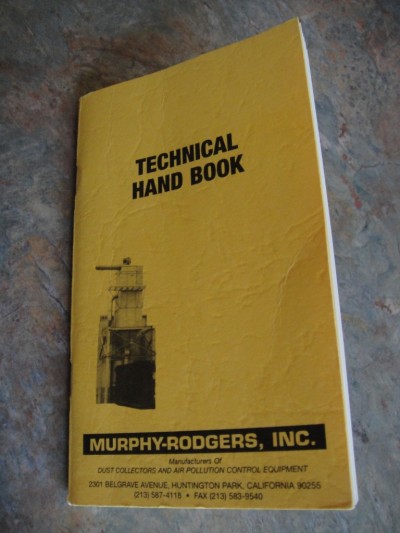
Commercial shop dust collector manufacturers are a better source of information than hobbyist brands because they have to comply with real regulations regarding workplace standards. Hobbyist dust collectors tend to cut corners that the customer base doesn’t demand so the prices are lower and more people buy them.
Filter Types and Dust Collector Types
Depending on the type of dust collection system you choose, you may have bag filters or cartridge filters. Bag filters can be woven polyester, regular felt, or treated felt. Cartridge filters are usually cylindrical in shape and have pleats (corrugated pyramid shaped folds) to maximize filter surface area in a compact form.
If you want a single stage dust collector, for example, some come with a cartridge filter and others with a bag filter. Same with two-stage and cyclone types–you can choose. Mine is a single-stage, meaning that chips aren’t going through a “particle separation” stage; all just goes through the impeller directly into the bags. This system is harder on the filters and impellers, but is much less expensive. If you design it right, make a few modifications as described below, it works ok, but it may not pass a clean-room lab test unless you seal everything.
On single-stage models, the top bag is usually the “breather bag”, while the bottom bag just collects the fallen dust and chips. Sometimes the bottom bag is designed to also breathe (meaning it’s not sealed), but often it’s a less effective plain woven bag filter.
Filter-felt would be a better choice, but it’s not meant to support heavy loads of sawdust so you typically see woven polyester. You’re better off sealing this up by using either a 5-6 mil solid poly bag, a drum, or a #8 duck canvas bag that doesn’t allow air to pass through. If you do this, you need to make sure the top bag has enough surface area to handle the airflow. More on that below.
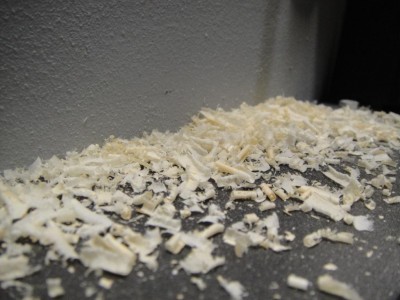
Chips and shavings are not what you should worry about; it’s the really tiny dust you can’t see that damages your respiratory system, and most dust collectors don’t filter these very well. Kind of ashame when you think about it, since they know that small shops typically recirculate the air.
Exhausting Outside vs. Inside
A question I often see (and get) is whether to exhaust your dust collector outside or recirculate it inside your shop. The pro’s and con’s are as follows:
Recirculate
The good:
- You won’t lose heated or cooled air since you’re keeping it within your shop envelope
- Reduced noise to the outside
- No worries about regulations regarding what you’re discharging
The bad:
- You have to really make sure the air is well-filtered before sending it back into your shop
- Small particle filtration takes a good filter with a lot of surface area to avoid losing airflow due to clogging
- Cleaning the filters can stir up dust
Exhaust outside
The good:
- You don’t need to worry about filtration as much; if you just filter out say down to 10-20 micron or even a little bigger so you won’t blow sawdust at your neighbor.
- Filter cleaning will be more of a pressure-drop issue than a filter damage issue
The bad:
- You will want to check your local regulations on discharging air (what level of filtration is needed)
- Noise will be an issue, so you want to use a “soundtrap” or duct muffler on the discharge. This is just a double tube, perforated on the inside with sound-absorbing insulation sandwiched between. These can be expensive, but you can make your own. The best way is to know how many dB of each octave band your collector produces and get a custom soundtrap fabricated to attenuate the problem frequencies
- You will be taking out a lot of CFM from your shop, and the exact same amount of air will be sucked in from the outdoors. You need a good source of make-up air, sized at least 500 fpm using the free area of the opening (louvers have roughly 50% free area, but look up the exact value from the manufacturer).
- Air you’re drawing in through louvers or an open door can just as easily contain dust and dirt, unless you filter that too. I mean, tap the top of your attic insulation and you’ll see a puff of dust. That’s from outside air being drawn into your attic.
- It is dangerous to do this if you have any gas-fired, open-combustion furnace, dryer, water heater, or other appliance in your shop, basement, or garage
- If it’s really cold or hot outside any air conditioning you’re doing to cool or heat your shop will be ineffective because you’re tossing that air right outside again, and drawing in whatever’s outside at a fast rate. For example, if your dust collector’s pulling 800 CFM, and you have a 20×20 shop with 9 ft. ceilings, you’re changing all the air in there every 4-1/2 minutes! You would either need to incorporate energy recovery systems to the in/ out airstreams, condition or at least temper the incoming air, or switch to radiant heat which can better keep up with the air changes. These options are, of course, expensive. I do have electric radiant heat and it can tolerate an open door because it heats up objects around it and that helps keep me warm enough (but I’m in CA hehe). But I’d probably have to add wattage if I didn’t recirculate the duct collection air.
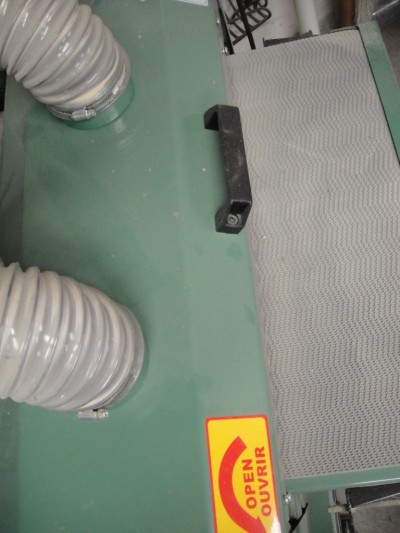
My drum sander produces lots of fine dust. To get better airflow these two 4” ducts will be connected to a larger diameter duct where the static pressure will be lower but not too large that I don’t get the proper velocity. Right now it’s not getting enough CFM so some fine dust is able to escape.
Protecting Your Filters From Excessive Dust Loading
Some people go through all sorts of trouble to get all the chips and dust separated out of the airstream before it hits the impeller or the filters, typically using either a separator bin or a cyclone section. This is fine, but causes a significant pressure drop in your overall system (could be 4” or so). You need to accommodate this by increasing your motor size and making sure the impeller and motor can deliver the CFM you want at the overall static pressure for your exact system. The benefit is that your impellers don’t get beat up, and your filters won’t load up as quickly or get damaged by increased pressure due to filter clogging.
My “ultimate” dust extraction design would incorporate cyclone separation, and probably a generously sized two-stage filter system, and have the capability to switch from “recirculate mode” to “outside discharge mode”.
Some newer Jet dust collector models incorporate a “vortex cone” separator into their single-stage systems. Basically it’s an inverted, shaped sheet steel cone that acts like a shield or poor man’s cyclone device and enhances particle separation. The goal is to prolong filter life by slowing particle loading. It’s not a true cyclone, but it’s better than not having it for sure.
So if you have a single-stage system perhaps you could retrofit yours (I’m gonna…), or if you’re replacing one or in the market for a single-stage, take a look at that. You’ll really want one if you’re using a cartridge-type filter on a single-stage unit. Big wood chips will screw up those filters fast.
What You Need to Know About Pressure Losses
If you have a basic understanding of what your dust collector is doing, and what factors affect performance, you can make better decisions about its design. Refer to the article Dust Collection Mastery and the Dust Collection Resource Page to get a solid overview on dust extraction design and options.
You have a lot of control over your design, and if you know the CFM target you’re going for with each tool, the required velocities, dust collection fitting options, and how to calculate pressure drop, then you can optimize your system. I’m in the process of putting an article together how I will size my dust collection system, drawing on my engineering experience doing HVAC and dust collection systems for larger shops, as well as some researched I’ve collected. It’s about time to incorporate what I know into my own workshop and plan for a significant upgrade.
Here we’re taking a close look at what you can do on the discharge side of your dust collector fan. Most woodworkers don’t think about reducing the system’s static pressure caused by the filter, but you absolutely can, and filter down to very fine particles.
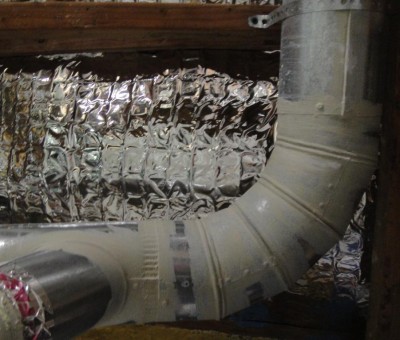
To reduce static pressure, use elbows with a curvature of at least 1.5 times the diameter. I could go a step further here and use a smoother one-piece elbow instead of a gored or segmented elbow.
An Important Note About Filter Certification
Whenever you’re buying a filter, whether a bag type or a pleated cartridge, you want to make sure it’s tested and certified, and rated while CLEAN.
Using filter bags, whether on a single-stage or on industrial-sized baghouse dust collectors, you’re using a dust cake layer to decrease the permeability of the filter and help stop small particles from getting through, but allow clean air molecules to pass.
A dust cake is a layer of dust on the inside of the bag fibers that lodges amongst the fibers that doesn’t shake loose after minor cleaning/ tapping of the bag. It’s on purpose, and many felt bags are surface-treated to hold just the right amount to form an effective barrier. This takes awhile to develop (it starts in a few hours but can take some time), so understand that it won’t be as efficient at stopping small particles at first, unless you get a really good one, like from American Fabric Filter Company. You’ve got to check the “clean” filter rating to see if it meets your goal. The AFF bags I’m ordering are quite effiicient even when clean.
WoodChip Tip: Don’t count on the dust cake necessarily, though you should size the filter to account for it to prevent loss of airflow, filter damage and particles being forced through under high pressures.
If you’re looking to further guarantee small particles don’t make it back into your shop, perhaps you can enclose your collector and have one wall be a bank of extremely generously sized fine filters. If you do this, test your airflow with and without that and make sure your overall system still works ok; don’t sacrifice needed CFM. The concept is similar to having a pre-filter and final filter like in many commercial air conditioning units and workshop air cleaners. Looking at my old dust collector design notes, I have a sketch for an enclosure with sound baffles and filters to help quiet the system. Not sure if I’ll do that but I’ll see how the new filter bags perform and think about it.
When it applies to pleated filters like cartridge types, ASHRAE Standard 52.2 is what you should refer to; filters that have a Minimum Efficiency Reporting Value, or MERV number. These numbers, such as “MERV 16” indicate the percentage of different size particles that are stopped, from 0.3 to 10 micron. The larger the number, the better the filter will be at stopping a greater % of smaller particles.
In order to get rated, the filters are tested according to a strict standard that includes multiple tests at various velocities. The ratings are also listed with the velocity at which they were certified. So know what your CFM is, and divide by the filter media area to get the velocity through your filter.
For felt bag filters, a BIA Classification is sometimes used; BIA stands for Berufsgenossenschaftliches Institut für Arbeitssicherheit (I’m not kidding…). These tests (described in the ZH1/487 Standard for indoor recirculation) are carried out on clean filter media at an 11 fpm velocity. A concentration of 200 mg per cubic meter of quartz dust in air is used for the test, and 90% of the particles are 0.2 to 2 micron. They average 6 tests.
They measure air quality in mg per cubic meter of dust particles, and give the filter a classification based on the resulting concentration after 6 tests. Each certification has a maximum allowable concentration of particulates that would be present in the workplace or shop air. Ask your manufacturer for the test data, and which certification they used and make sure it was tested in clean condition. I’d look at trying to get 0.5 to 1 micron efficiencies around 98%+ if you can.
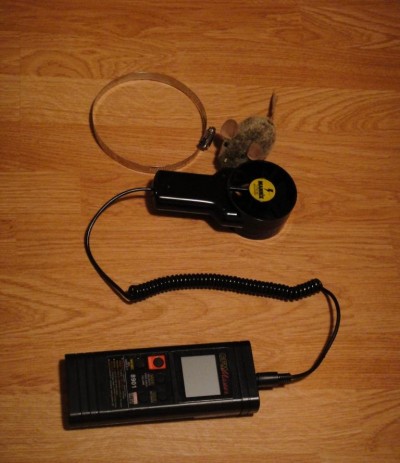
Using this anemometer I can measure the velocity in my dust extraction ductwork and by multiplying it by the area (in sq. ft.) I get the CFM.
My new cool toy: Anemometer (used to measure airflow; take a velocity measurement and multiply it by the duct area in sq. ft. to get the CFM.)
Filter Bags
Ok, back to my dust collector. My plan is to get a company, probably American Fabric Filter Co., to provide an appropriately sized upper filter bag to replace my current one. It’ll be much larger to account for the fact that my lower dust catcher won’t be a “breather bag” but a sealed container, which I’ll also get from AFF. I took their business card years ago at an AWFS show, and it’s still on my desk with the little sample of 16 oz PE felt and singed Shaker felt stapled to it. I talked to the guy at the booth for quite awhile, but never got around to ordering the bag.
Now I’m quite motivated after seeing all that dust powder and digging deeper into what performance a recirculating dust collection system could (and should) provide. Dust extraction systems I’ve designed and specified for commercial shops had their filter discharge to the outdoors, so filtration was just a matter of outside air quality regulations. But inside you really want to make it as clean as you can because you’re directly breathing that.
From reading AFF’s website, I think the most economical solution for me at this point is to get a singed-surface, non-woven polyester felt bag to retrofit my existing collector. This bag will filter 1 micron at near-perfect efficiency after a DUST CAKE has established itself, but make sure you ask about the filter efficiency while CLEAN at 1 micron, meaning what % of that size particle it captures; you’re looking for 98% at least. So if their filter captures 76% of 2 micron particles and 99% of 5 micron particles, then to me you’re really getting a 5 micron filter.
American Fabric Filter Co. sent me some info I requested regarding their felt filter bags. I was glad to see that they do have an official 3rd Party particle arrestance efficiency rating. They gave me a BIA Classification chart that shows test condition results for their 12 oz. singed polyester felt filter bag before the dust cake has built up (clean). This clean media has an air permeability of 35-45 CFM at 0.5” static pressure. From 0 to 10 microns, I see on the graph that it ranges between 96% and 98%. I see that at exactly 1 micron on the graph, it’s right at 96-97%. Above 10 microns it is rated at 99.9% to 100% efficient.
Pretty darn good while still clean. This particular filter was given a “G” BIA classification, indicating that 99.5% efficiency was achieved for dust separation with dust of concentration greater than 0.1 mg per cubic meter. For comparison, a “C” rating would mean achieving 99.9%. And it’ll only get better as the dust cake builds, assuming you size the filter bag to prevent excessive pressures. I’ll see what they have available for finer filtration and compare the required surface areas.
They point out that there are a few variables that will change a bag filter’s performance. These include the type of dust you’re actually collecting (slippery, sticky, agglomerating, etc.), felt surface treatment (plain, singed, glazed, PTFE membrane coated, or bath treated with release agents), correct bag sizing to avoid over-pressurization forcing particles out, and poor maintenance (over cleaning/ washing).
The beauty of felt filter bags is that they require very little maintenance. Every so often they recommend you tap the bag to knock excessive dust off the inside surfaces. A singed felt will retain a controlled dust cake for you. If you size the bag to handle the CFM you want with a dust cake layer, you’ll be fine.
Large baghouse-type dust collectors have auto-shakers or compressed air cleaning systems to automate this process. The singed felt holds onto a certain amount of dust to serve as the dust cake layer, and any excess tends to fall off or come off with a bit of shaking or tapping. This means that your pressure drop won’t get out of control generally.
My recommendation is you check it (measure your static pressure using a manometer) every so often, and tap your filter bags now and again. I bought an anemometer and I use it to test the velocity I’m getting out of each duct, and multiply that by the area to get the CFM. You can compute the pressure difference you’re getting using your fan curve, but this is tricky and not too accurate. You can buy a manometer to see what the pressure drop is with a clean vs. dirty filter so you know when it’s time to tap off the excessive dust cake. Ask the manufacturer for their guidelines.
So how large should the filter bag be? AFF has indicated that ideal systems will have between 5 and 10 CFM per square foot of fabric. Ultimately, I’ll tell the manufacturer what my needs are (desired max dirty filter pressure drop, level of fine dust filtration, etc.) and let them recommend the material, and calculate the area needed to keep the pressure drop low given my CFM. The idea is to optimize what I’ve got, and later I can upgrade if I think I need more air for certain tools.
It seems the goal is to have 50-100% excess air capacity while clean, with a target static pressure loss of 0.5”. Many manufacturers of dust collectors undersize the bags, which means that when a dust cake develops you lose more airflow than is appropriate for your tools.
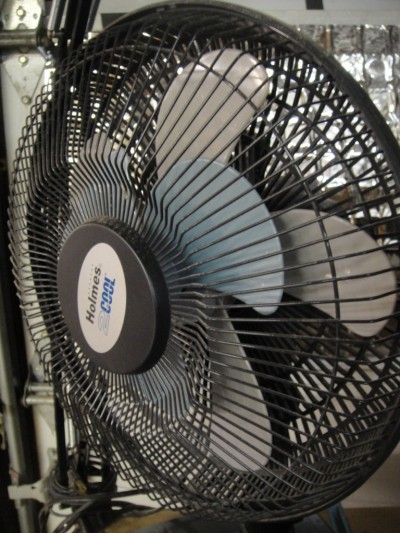
Sometimes I aim the fan outside and crack open the garage door a little bit to help exchange the air in the shop.
Cartridge Filters
A cartridge filter is another option to save space, but I think the maintenance would be a hassle for me since I have no particle separation. Even cyclones don’t have perfect small-particle separation so their filters often get loaded and experience high pressure drops, but if you get enough filter surface area, and do a few other things, a good cartridge filter can get really fine particles.
Cartridge filters have pleated (folded) filter media wrapped in a cylinder shape, usually. The pleated (accordion) design increases the filter surface area in a compact geometry to save space. These filter materials can be damaged by high dust collector outlet pressures resulting from excessively loaded (dust laden) filter media, which can force larger particles through. They can also be damaged by trying to clean them with high pressure compressed air. A damaged filter (bigger holes in the media) will mean you’re blasting dust right back into your shop.
There are some choices for filter media material, such as plain old cellulose, cellulose-polyester mix, and then there’s spun-bonded polyester. On the MPF Engineered Filters website, using polyester increases the filter’s abrasion resistance, and the spun-bonded polyester has the added benefit of promoting good dust cake release to keep the pressure drop in check. To me this means the cheaper cellulose material is less tolerant of cleaning and you’ll wind up replacing it more often.
Some people with cyclone dust collectors put a catcher bin below their cartridge filters. This will contain dust that they knock off the pleated media, and prevent dust accumulation in the cartridge. If you have a single-stage machine, then the dust bin is usually already below the filter.
Jet and Powermatic dust collectors have a flapper device inside their cartridge filters that allows you to crank a handle that rotates flexible paddles to flick off dust from the inside of the cartridge, keeping your pressure drop in check. Some say that all you need to do is tap the top of the cartridge. I have a pleated cartridge filter on my shop vacuum, and I have to bang the top pretty hard to knock off the excess dust. I wonder how much maintenance a full-size dust collector cartridge filter is; if you have one let everyone know in the comments below.
As far as the required surface area is concerned, the “air-to-cloth ratio” can vary depending on the filter media material, and the desired pressure drop. Different levels of filtration will naturally have different pressure drops per sq. inch of filter material.
If the static pressure is too high (meaning not enough filter area) particles can be forced through the material anyway and damage the filter. I would size them assuming a dirty filter condition with a permanent dust cake established (the dust that remains after a light tapping). Ask your manufacturer for a “dirty filter” pressure drop per sq. ft. of filter, then do some math yourself. Ask them the recommended “safe” static pressure and aim for less than that.
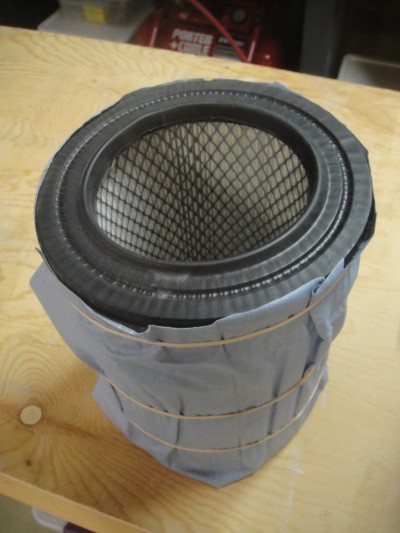
I use a cartridge filter for my shop vacuum. I had this temporary filter cloth on it while I was sucking up drywall dust, so the filter wouldn’t get all clogged up. It did cause quite a pressure drop so I just use the filter by itself normally and it works ok. I sometimes wonder if the pressure causes particles to be forced through the media as it loads up with more and more dust. Anyone measure that?
A Blurb About Air Cleaners
I don’t currently own an air cleaner, because my brain is going back and forth on the proper way to deal with already-airborne fine dust. I’m not sure the “conventional” ceiling suspended air cleaner is the ideal way to go yet. I hope to learn from comments people leave as I continue to read as much as I can.
If you do want one, size for at least a 5 minute air change rate, which is your shop’s volume divided by 5 minutes to get the CFM. Just be aware that you’re not evenly sending air from all parts of your shop through the filter; the air closest to the intake will be recirculated many times before the air in the far corner will even make its way over. Some say the actual time to filter all the air is around 7 times longer than the calculated “air change rate”. If I use air cleaners, I’m thinking maybe use at least two units in my 3-car garage-sized shop.
Be careful with placement also, because if the air cleaner suspended high you’re not cleaning the “breathing zone” air like you may think, and if your shop is dusty you may be stirring that up with the air currents it’s creating…more reason to wear a mask…not to mention you want the air cleaner to filter to MERV 15 or 16 levels if you can (but that can quickly load up the filters), so use a series of filters and a pressure-drop indicator to know it’s time to change them.
By leaving the unit on when you leave, you will return for the next session to a cleaner shop, so I think for this reason it’s worth getting one.
You can float around the internet to find endless debate. My thought is that if it’s a nice day you may be better off exchanging inside air with outside air using cross-ventilation. I’m gonna do this with my finishing room; put an exhaust fan in front of me (where I breathe) and a make-up air louver (with a filter) behind me drawing in air from outside across my breathing zone and back outside away from me.
You could look into clean room design, and implement HEPA (High Efficiency Particulate Arrestance) or ULPA (Ultra Low Penetration Air) filters, but I think that’s overkill. An HVAC air handler could be dedicated to the shop and distribute a 5-minute air change rate worth of air and have HEPA filter return grilles distributed around the shop. This would take quite a motor to handle the static pressure (calculated using the longest run, return air plus supply), but you’d have clean air!
You could also have a vestibule or mud room with doors on either side that has an “air shower” to decontaminate you, but using compressed air to dust off outside is easier.
Things like sanding I like to do outside using saw horses on my concrete patio, but sometimes I hafta do that inside (when it’s late for the neighbors’ sake, or too hot or cold out). That’s where I think a powerful downdraft table with really good filtration would be a good idea.
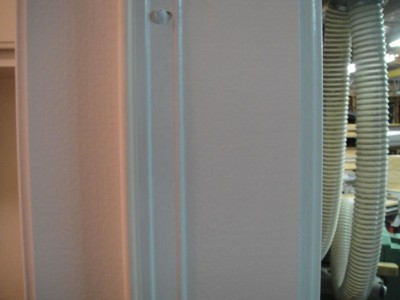
Any door from your shop to your house should be weatherstripped. My eventual plan is to have two doors for soundproofing reasons, and will help prevent dust from getting in since both doors will be sealed.
Remember This
At least make some improvements to your overall dust collection system, especially your filtration, even if you don’t want to go “all out”, but know your overall options and aim high.
Don’t make the mistake of undersizing your filters. This is a big deal because excessive dust buildup will reduce the air permeability of the filter, and the high pressures can force particles through, defeating the purpose and damaging cartridge type filters. It also reduces your CFM, which is bad because now you’re not picking up dust as effectively, which leaves it in a cloud near where you’re standing.
Where you tend to make small dust particles is with sanding. I’ve long wanted a downdraft table. Right now I hook a shop vacuum to power sanders but adding a properly designed downdraft table would be better. On a nice day, I find wearing a dust mask outside using saw horses works even better, and I don’t have to wipe anything down afterward.
If you’re dust sensitive, or using higher-than-normal toxic wood, you’ll want to take multiple measures including:
- Wearing a NIOSH-rated cartridge dust mask certified for the really fine wood dust in the 0.5 or better range (most people don’t bother, I know)
- Use general exhaust ventilation with good crossflow using open doors (during good weather). This works pretty well for me, but hey I live in California
- Using a really high quality ambient air cleaner on bad weather days or if you can’t get outside air cross-ventilation (see the blurb on air cleaners above)
- Sealed door jambs to your house (I have compressible weatherstripping on my fire door),
- Use compressed air (while wearing a mask) and dust yourself off outside before re-entering your house, and
- Frequently wipe dust powder off shop surfaces and the floor since it gets stirred up so easily (why rebreathe it?).
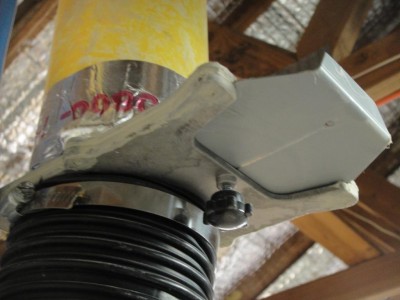
I measured 6,500 fpm out of my planer duct, which is about 567 cfm. This has been enough to keep dust and chips away, but since this is close to the collector if I use a 5” duct and connection port I bet I could increase to a much better number to help pull in more. I’ll test 5” and 6” and see what velocities I get with my new filter bags. Some other improvements I plan to make include smoother flex duct and a better hose clamp. This type doesn’t sit quite right.
Yeah, you can design to forum-approved “clean room” standards with HEPA or ULPA filters if you want, but I realize that a particle or two will make its way up my nose, just like you can’t avoid germs unless you live in a bubble. I have a vacuum cleaner that filters allergens, but it still stirs up dust that isn’t captured. Think about it, the outside air has a certain level of dust anyway. But certain wood species may cause allergic reactions or is just plain not good to breathe, so you do want to minimize your exposure to that. My goal is to reduce my exposure by:
- Improving filtration to small particle sizes, around 1 micron at least (if you can, do less than a micron …)
- Reducing filter pressure drop (my goal is 0.5”)
- Properly sizing the filter (under dust-loaded conditions) to keep airflows the best they can be
- Optimizing capture at the source the best you can using custom shields/ enclosures
- Getting enough CFM at particular tools, and
- Keeping the shop a bit cleaner by wiping up dust from surfaces so you don’t stir it up and rebreathe it.
I have dry weather and a garage roll-up door, so it’s easy for me to hose down the floor every so often. I do this every few months.
Realize that this whole shop evolution thing is a process, and if you did everything at once you’d spend 10 years building your shop with zero projects to show for it. So just integrate these improvements in priority order as you go along. But certainly don’t make dust collection an afterthought; integrate it into your workshop design.
Related Articles:
Dust Collection Mastery
Dust Collection System Layout ‘Strategeries’
Dust Collection Ductwork and Fittings Done Right
Dust Collection Resource Page
For more guidance in assembling your Workshop Design, click on the Starting? Go Here! category and read those first.
Connect with me on Facebook, and follow me on Twitter for more ninja tips to Optimize Your Woodshop!
And, if you’re on Twitter, be sure to follow #woodchat every Wednesday night, at 6:00 pm, PST.
Gotta get more clamps,
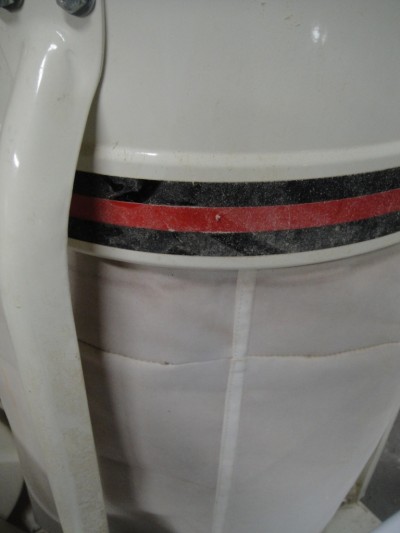
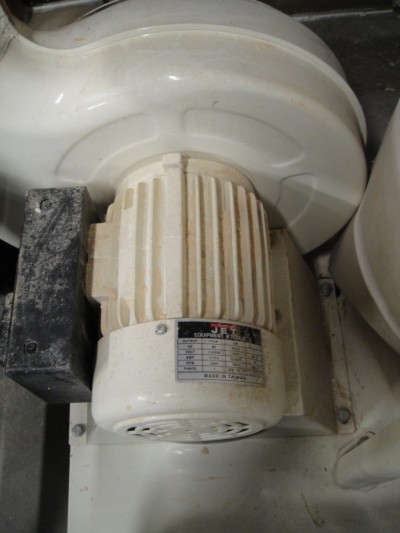








 How I went from a cluttered and disorganized shop to a super-productive layout with a convenient dust collection and electrical set-up.
How I went from a cluttered and disorganized shop to a super-productive layout with a convenient dust collection and electrical set-up. 


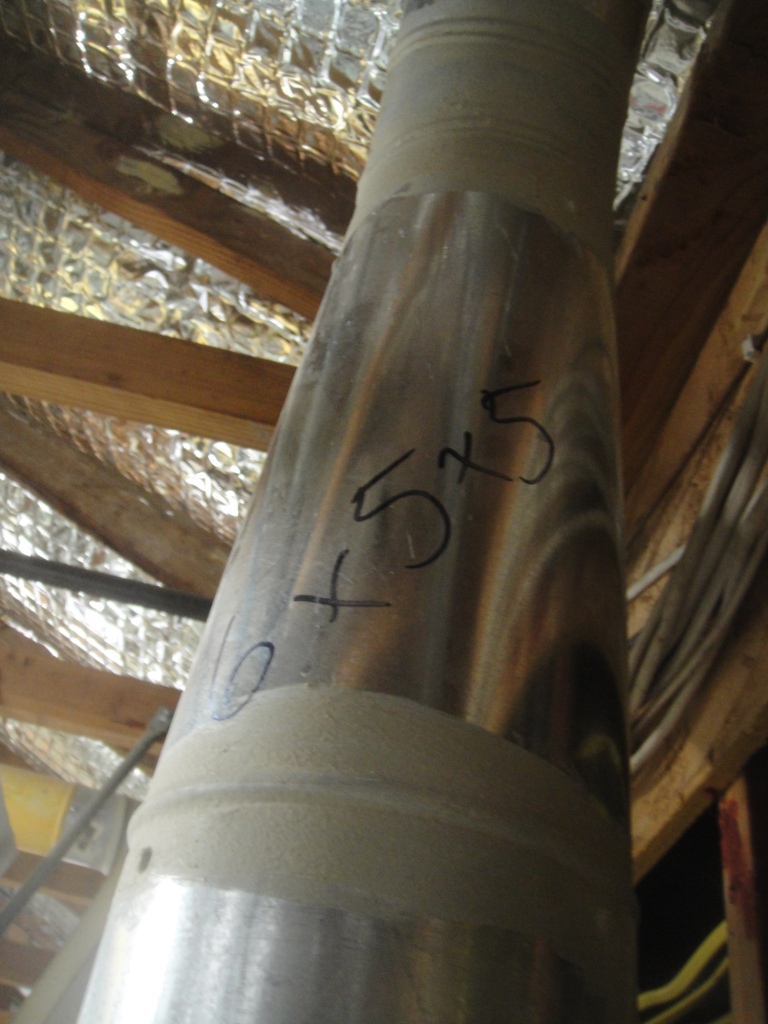
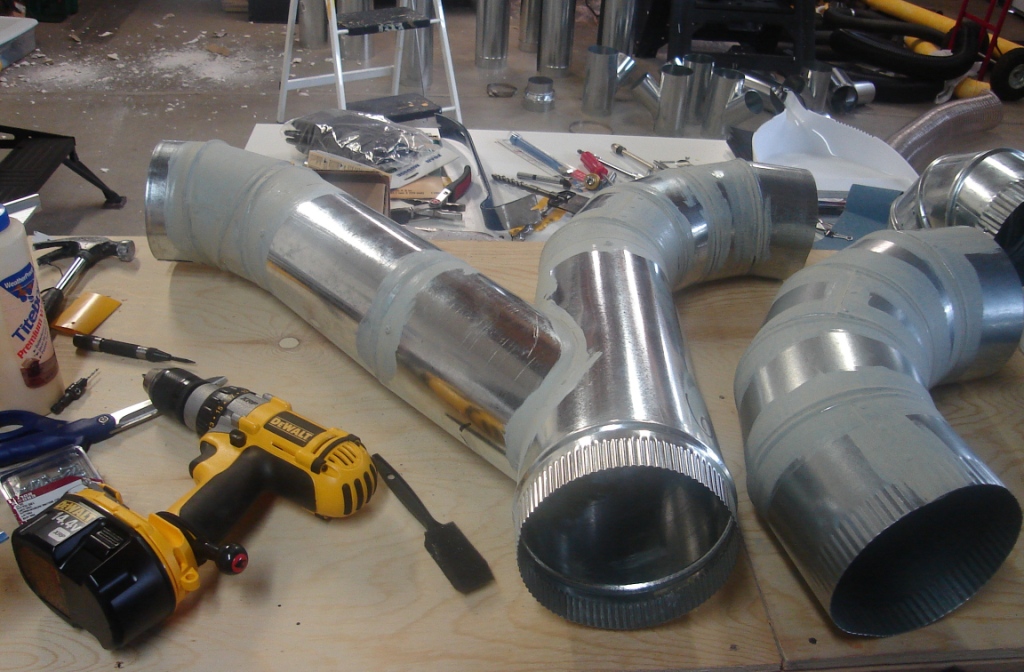
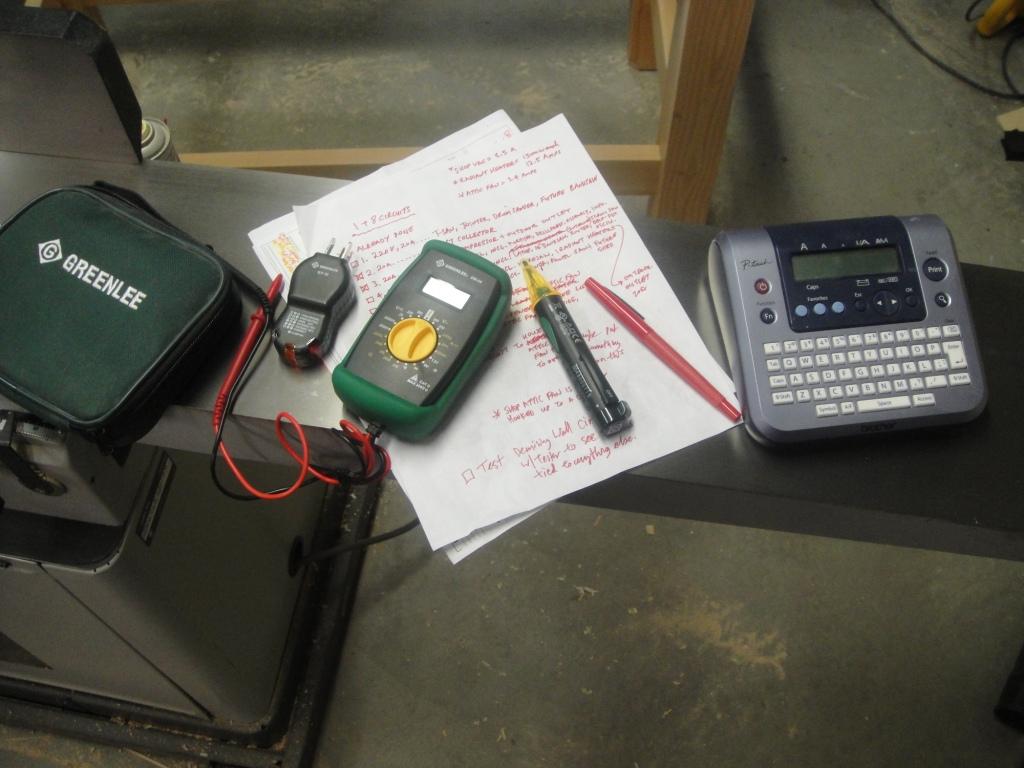




Bobby
Lov’s ya once, Lov’s ya Twice—Lov’s ya more than Beans and Rice! That’s a “Naturally NAwlins” Salutation for a job well done in putting your website together.
Let me share why the warm into. I’m 73 and my son are very enthusiastic hobbyist Wood Workers, on July 7th2014 my 50’ x 25’ WW shop burnt down, which left me devastated.
However, the next day I looked at the bright side and saw this as an opportunity to rebuild from the ground up and cure all the ills of the old shop.
Also, having replacement insurance was a blessing however I had to make a list of all destroyed items which meant I spent the next two months going through the ashes collecting, identifying and entering said items in the database for the insurance company for reimbursement.
Now the next step was to visualize the scope of the work for the rebuilding process and then break this process down into bite size parts of sections. Which was/is a harder challenge to put on paper – and after having a shop that out needs for years.
Then I found your website and it was like you were reading my mind, except every topic and its content was much more detailed and complete than my outlines.
All your dissertation are wonderful, I especially enjoyed the Dust Collection Ducking and Fittings and your articles I call taking the Mistry out of Dust Collection. I had and have on order a Non Cyclone dust collection unit and your discussion on the bags their functions was like taking a lesson. I will order the AFF bags for my new unit and now have their website as well as yours on a Short Cut in my computer.
Bobby I could continue however I think your got the message finding your website at my stage on planning and construction of our new wood working work shop was a God sent.
Another topic I’m toiling with is correct type piping to be used in a central air compressor system. Any suggestions?
What A Wonderful World
Roy Zanca
New Orleans
Hm: 504-242-1705
Cel: 504-491-5149
I prefer to design the collector as an industrial style bag house, where the air moves from the outside of the bag in, and the bag sits in a collection container. Using smooth surface (ptfe) or mesh bags prevents clogging the bag, the bag doesn’t impede air flow over time as it never fills with dust. Just as you use different grits sanding to remove irregularities of different sizes, multiple bags separate the fines and prevent overwhelming the next smaller size filter with larger particles. My preference for a final stage is 0.5 microns.
Hmmm…I’ve never looked into that in detail; I’m curious as to what it looks like. Is your current set up using this configuration?